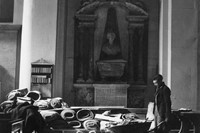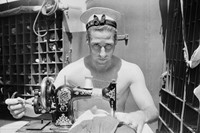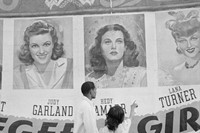Cecil Beaton’s world-wide reputation hangs largely on his pre-war images of London’s Bright Young Things, sumptuous portraits of the Royal family, British aristocrats and Hollywood stars, and fashion photography for the likes of Vogue and Vanity
Cecil Beaton’s world-wide reputation hangs largely on his images of London’s Bright Young Things, sumptuous portraits of the Royal family, British aristocrats and Hollywood stars, and fashion photography for the likes of Vogue and Vanity Fair. Winning Oscars for his set and costume designs for Gigi and My Fair Lady, his star is firmly ensconced in the “society” firmament. However, as a new exhibition opening today at the Imperial War Museum shows, Beaton’s passion and talent for photography extended far beyond diamond encrusted debutantes and their ermine clad mamas – indeed this exhibition shows him to have been one of the most important photo-journalists of the Second World War.
"Beaton’s passion and talent for photography extended far beyond diamond encrusted debutantes and their ermine clad mamas..."
Starting with coverage of a mutilated London crumbling under the barrage of the Blitz, the intrepid photographer shot candid portraits and documentary series from a staggering range of wartime standpoints: from the Tyneside shipyards and the RAF landing fields of Biggen Hill, to the palaces of colonial India, the depths of the Burmese jungle and the desert plains of Egypt and Iraq. Over 7000 works survived; images that by turn show great beauty, document little known frontiers of war, celebrate pivotal individuals, recall forgotten horrors, and allow glimmers of humour in the often-unalloyed tragedy of our wartime reminiscence.
Despite working gruelling hours, in often difficult, dangerous and fragile conditions, Beaton continued to apply his trademark elegant compositional style to his images, a tendancy recognised in the show's title - Theatre of War. Fragments of a collapsing ceiling in Libya take on a surrealist look under his lens; straight military portraits are leavened with innovative use of light and shadow; the innocuous becomes beautiful, as in a movingly simple shot of soldiers’ pyjamas blowing in the desert wind. Clearly wartime did not see a complete separation from his pre- and post war style and subject matter. Ghurkha snipers and Indian rag and bone men rub shoulders with many of the grandees from the colonial Raj, complete with the feathered hats and swords of court dress. And every so often, we catch a glimpse of the photographer himself – reflected between gorgeous tiled pillars, impeccably dressed in suit, crisp white shirt and bow tie, legs crossed – a dandy to the end.
Cecil Beaton: Theatre of War runs until January 1 at the Imperial War Museum, London. The exhibition book is out now, published by Random House.
Text by Tish Wrigley



